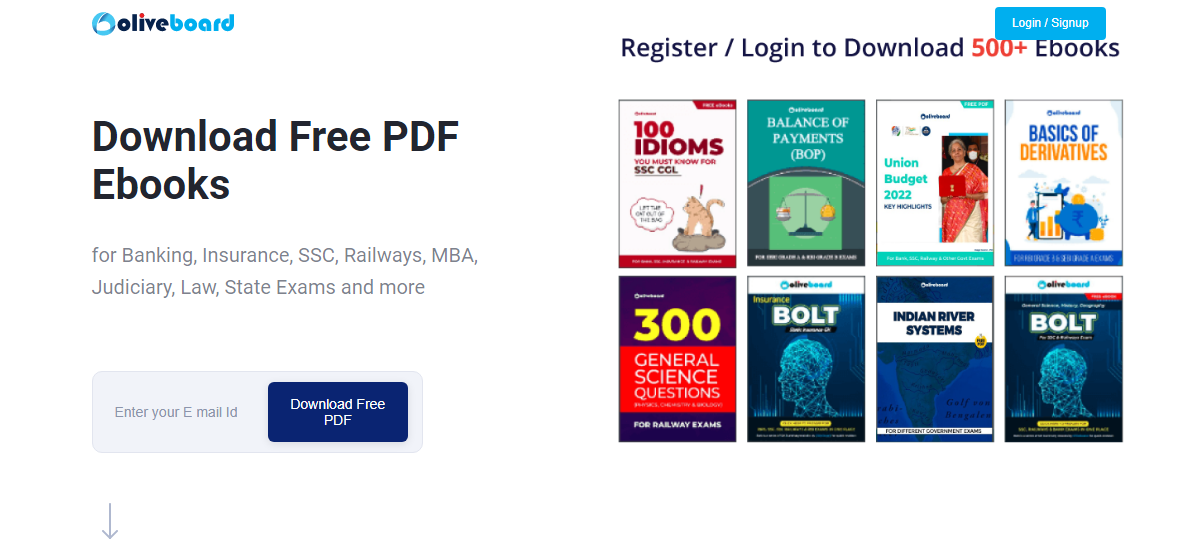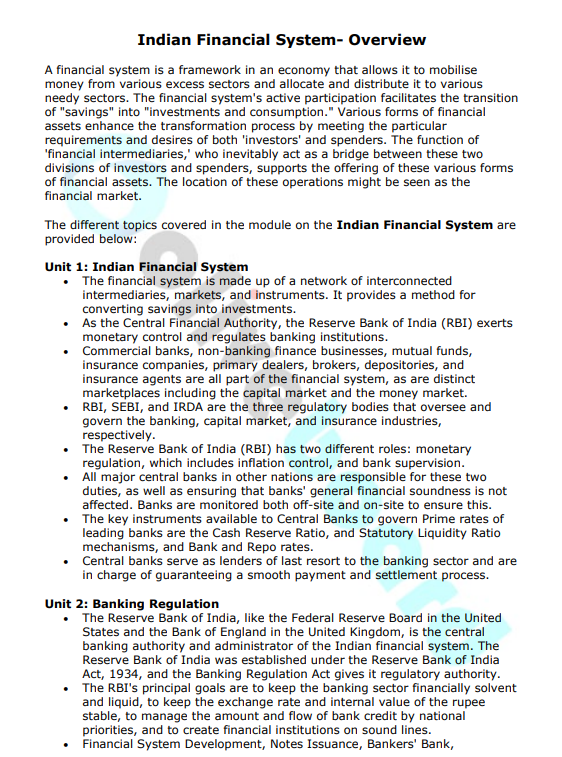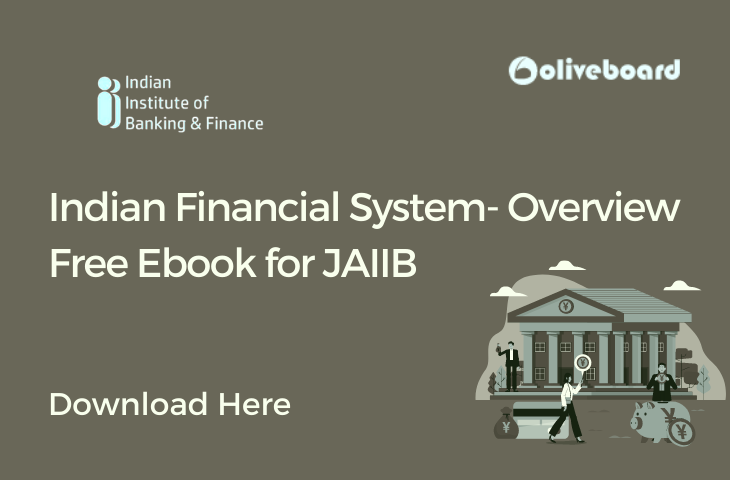A financial system is a framework in an economy that allows it to mobilize money from various excess sectors and allocate and distribute it to various needy sectors. The financial system’s active participation facilitates the transition of “savings” into “investments and consumption.” Various forms of financial assets enhance the transformation process by meeting the particular requirements and desires of both ‘investors’ and spenders. Indian Financial System is a subject that every JAIIB aspirant should be aware of. Indian Financial System – overview is an ebook that will give you the idea what all main topics you need to cover under this section.
Download the Indian Financial System- Overview Ebook
How to Download Indian Financial System- Overview E-book for JAIIB?
Step 1: Click on the download link. You will be redirected to Oliveboard’s FREE E-Books Page.

Step 2: Create a free Oliveboard account or login using your existing Oliveboard account details
Step 3: Download the book by clicking on the link presented on the page.
Introduction
A financial system is a framework in an economy that allows it to mobilize money from various excess sectors and allocate and distribute it to various needy sectors. The financial system’s active participation facilitates the transition of “savings” into “investments and consumption.” Various forms of financial assets enhance the transformation process by meeting the particular requirements and desires of both ‘investors’ and spenders. The function of ‘financial intermediaries,’ who inevitably act as a bridge between these two divisions of investors and spenders, supports the offering of these various forms of financial assets. The location of these operations might be seen as the financial market.
The different topics covered in the module on the Indian Financial System are provided below:
Unit 1: Indian Financial System
- The financial system is made up of a network of interconnected intermediaries, markets, and instruments. It provides a method for converting savings into investments.
- As the Central Financial Authority, the Reserve Bank of India (RBI) exerts monetary control and regulates banking institutions.
- Commercial banks, non-banking finance businesses, mutual funds, insurance companies, primary dealers, brokers, depositories, and insurance agents are all part of the financial system, as are distinct marketplaces including the capital market and the money market.
- RBI, SEBI, and IRDA are the three regulatory bodies that oversee and govern the banking, capital market, and insurance industries, respectively.
- The Reserve Bank of India (RBI) has two different roles: monetary regulation, which includes inflation control, and bank supervision.
- All major central banks in other nations are responsible for these two duties, as well as ensuring that banks’ general financial soundness is not affected. Banks are monitored both off-site and on-site to ensure this.
- The key instruments available to Central Banks to govern Prime rates of leading banks are the Cash Reserve Ratio, and Statutory Liquidity Ratio mechanisms, and Bank and Repo rates.
- Central banks serve as lenders of last resort to the banking sector and are in charge of guaranteeing a smooth payment and settlement process.
Unit 2: Banking Regulation
- The Reserve Bank of India, like the Federal Reserve Board in the United States and the Bank of England in the United Kingdom, is the central banking authority and administrator of the Indian financial system. The Reserve Bank of India was established under the Reserve Bank of India Act, 1934, and the Banking Regulation Act gives it regulatory authority.
- The RBI’s principal goals are to keep the banking sector financially solvent and liquid, to keep the exchange rate and internal value of the rupee stable, to manage the amount and flow of bank credit by national priorities, and to create financial institutions on sound lines.
- Financial System Development, Notes Issuance, Bankers’ Bank, Government Banker, Banks’ Supervision, Exchange Control, and Monetary Control are some of its key responsibilities.
- The Statutory Liquidity Ratio, Cash Reserve Ratio, Bank Rate, Open Market Operations and Selective Credit Control are the RBI’s key monetary control instruments.
Unit 3: Retail Banking, Wholesale and International Banking
Banks were also in severe need of expanding their loan portfolios and diversifying their portfolio risk. Banks took advantage of this chance to meet the diverse financial needs of individuals by segmenting them as a different business market and calling it “Retail Banking.” As a result, retail banking may be defined as performing banking with individual consumers.
Wholesale banking refers to doing business with industrial and business entities, primarily corporations and trading houses, such as international corporations, local corporations, and government-owned enterprises. In India, banks have traditionally handled this form of business, which is also known as Corporate Banking or Commercial Banking.
Every country produces commodities and services over its needs and must sell (export) its excess output to other countries. Similarly, no nation can meet all of its demands on its own. Therefore it must acquire (import) certain commodities and services from other countries to bridge the gap between demand and supply in its economy. Furthermore, under a liberalized free-trade economy, the people and the government of one nation may invest capital and labor in another country, earning revenue in the form of profits, dividends, interest, royalties, and other forms of income. The foreign exchange market is where each country/people may pay for their needs and receive their benefits in their currency.
Take a Sneak Peek at the Indian Financial System- Overview E-book

Conclusion
This was all about Indian Financial System- Overview for JAIIB. Our goal is to provide candidates with information that will help them prepare for the JAIIB exam.
Keep following Oliveboard for more updates. To stay updated, follow Oliveboard on Facebook and Telegram.
FAQs
A. A merger also referred to as amalgamation, is described as the merger of two or more corporations into a single entity, one of which retains its name (or a combined new name) while the others cease to exist.
A. Banks took advantage of this chance to meet the diverse financial needs of individuals by segmenting them as a different business market and calling it “Retail Banking.”
JAIIB Study Material Compilation
Also Read:
- Preparation Tips for JAIIB Exam- Last Minute Strategy
- JAIIB Revision Plan- Last 10 Days Plan
- JAIIB Frequently Asked Questions- 2022| Check Here (oliveboard.in)
- JAIIB Genius | JAIIB Weekly Quiz PDF – JAIIB Questions PDF (oliveboard.in)
- JAIIB Full Form – Junior Associate of the Indian Institute of Bankers (oliveboard.in)
- JAIIB and CAIIB Books- Exams Syllabus, Books, and more (oliveboard.in)
Also Check:
- JAIIB 2022 Exam -Notification Released (oliveboard.in)
- JAIIB Notification 2022 – Notification PDF, Eligibility, (oliveboard.in)
- JAIIB Apply Online – Application Form 2022, Fees, Instru (oliveboard.in)
- JAIIB Eligibility – Age, Degree, Nationality, Members (oliveboard.in)
- JAIIB Syllabus – Complete List of Papers, Modules (oliveboard.in)
- JAIIB Exam Pattern 2022 – Details of Pattern, Marking (oliveboard.in)
- JAIIB Admit Card November 2022 – Steps and Direct Download (oliveboard.in)
- JAIIB 2022 Cut Offs – Check JAIIB Minimum Cut Off (oliveboard.in)

Hello there! I’m a dedicated Government Job aspirant turned passionate writer & content marketer. My blogs are a one-stop destination for accurate and comprehensive information on exams like Regulatory Bodies, Banking, SSC, State PSCs, and more. I’m on a mission to provide you with all the details you need, conveniently in one place. When I’m not writing and marketing, you’ll find me happily experimenting in the kitchen, cooking up delightful treats. Join me on this journey of knowledge and flavors!
